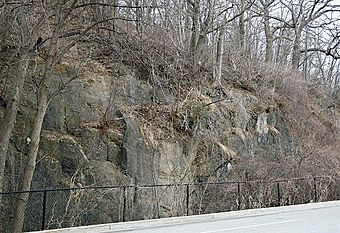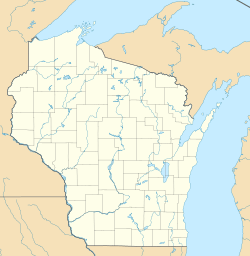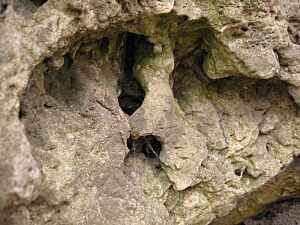Soldiers' Home Reef facts for kids
|
Soldiers' Home Reef
|
|
 |
|
| Location | Milwaukee, Wisconsin |
|---|---|
| Built | Silurian period fossilized coral reef. |
| NRHP reference No. | 93001617 |
Quick facts for kids Significant dates |
|
| Added to NRHP | November 4, 1993 |
| Designated NHL | November 4, 1993 |
Soldiers' Home Reef is a very old, fossilized coral reef found in Milwaukee, Wisconsin. It's also known by names like Rocky Point or Veterans' Hill. Imagine a coral reef from millions of years ago that turned into rock!
A scientist named Increase A. Lapham discovered this amazing rock formation in the 1830s. It was one of the first fossilized coral reefs ever described in North America, and even in the world. Because it's so special, Soldiers' Home Reef was named a National Historic Landmark in 1993.
Contents
Where is Soldiers' Home Reef?
This cool rock formation is located in Milwaukee, Wisconsin. You can find it on the grounds of the Clement J. Zablocki Veterans Affairs Medical Center. It's near where Wood Avenue and General Mitchell Boulevard meet.
The reef is part of a bluff, which is like a tall cliff. This bluff is about 70 feet (21 meters) high. The reef itself makes up the lower 35 feet (11 meters) of this bluff. It stretches for about 450 feet (137 meters) from east to west. This bluff is the only natural formation of its kind left in Milwaukee County.
How Soldiers' Home Reef Was Formed
Ancient Seas and Creatures
Soldiers' Home Reef began forming about 400 million years ago. This was during the Silurian period of the Paleozoic Era. Back then, Wisconsin was covered by a warm, shallow tropical sea.
In this ancient sea, tiny corals built a reef. Many other sea creatures lived there too. These included trilobites, cephalopods (like squids), brachiopods (shellfish), and bivalves (like clams). Over time, these creatures and the reef itself were preserved. They turned into limestone, which is a type of rock.
Glaciers and Erosion
Much later, during the Pleistocene Ice Age, huge glaciers moved across the land. These glaciers were like giant ice bulldozers. They moved over the hard limestone mound of the reef. But the reef was strong and resisted the grinding action of the ice.
The glaciers shaped the reef into a special form called a roche moutonnée. After the glaciers melted, they left behind deposits of rock and dirt. Later, the Menomonee River helped to uncover the reef again through erosion.
Discovering the Reef's Secrets
Increase Lapham's Finds
The importance of Soldiers' Home Reef was first noticed by Increase A. Lapham. He was an amateur geologist and is known as Wisconsin's first great scientist. In the 1830s, Lapham collected many fossils from this site. He also found fossils at other places nearby, like Schoonmaker Reef.
Lapham realized that these fossil-filled limestone rocks were different from the surrounding areas. However, he didn't fully understand that they were ancient reefs. He thought they were just pieces left over from a larger layer of rock that had worn away.
James Hall's Big Idea
In the 1850s, Lapham sent some of his fossils to James Hall. Hall was a paleontologist, a scientist who studies fossils, in New York. Hall was very interested in Lapham's discoveries. He visited Milwaukee himself in the 1850s.
When Hall saw Soldiers' Home Reef and other similar mounds, he noticed something important. He realized these mounds were not just leftover pieces of rock. Instead, they were individual, ancient reefs! Hall published his findings in 1862. This was a huge discovery. It was the first time fossilized reefs were identified in North America, and among the first in the world.
Thomas Chamberlin's Research
More understanding of these reefs came from Thomas Chrowder Chamberlin. In 1877, he wrote a book called Geology of Eastern Wisconsin. Chamberlin noticed that each fossilized reef in the area had slightly different types of creatures living in it. He used Soldiers' Home Reef and two others to create models. These models helped scientists understand how ancient reefs developed over time.
Why Soldiers' Home Reef is Still Important
Soldiers' Home Reef continued to be a very important site for paleontologists until 1939. Sadly, the two other limestone mounds that helped Lapham, Hall, and Chamberlin understand these reefs have been mostly destroyed by quarrying. Quarrying is when rock is dug out of the ground.
But Soldiers' Home Reef remains much as it was when these scientists studied it. It is still a mound with glacial deposits covering fossil-bearing limestone. This makes it a unique and valuable place for studying Earth's ancient past.




